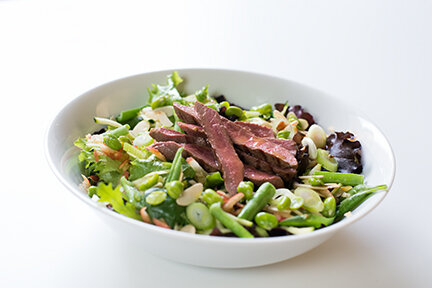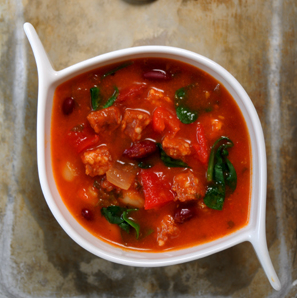TOP TIPS TO KEEP YOU IN THE RED ZONE
GRAZE ON FABULOUS FATS: Foods rich in essential fatty acids (particularly Omega 3s) keep you feeling fuller for longer, keep your brain sharp, plump up your skin cells delaying wrinkles, keep hair shiny and nails strong, accelerate fat loss and provide sustained energy.
Top Foods: Fresh nuts and seeds, nut and seed oils and butters, oily fish (fresh, frozen or tinned), Omega 3-rich eggs and avocado.
MAKE PROTEIN A PRIORITY: Adding a little quality protein to every meal and snack throughout the day ensures that the sugars derived from the carbohydrates you eat are delivered more slowly into the bloodstream thus avoiding energy dips and cravings.
Top Foods: Lean meats and poultry, game, eggs, beans, lentils, chickpeas and hard cheeses.
BUY A BIGGER HANDBAG/BRIEFCASE: The power of a portable snack can’t be overstressed! With just a little pre-planning you can ensure that you keep the hunger monster at bay by grazing on a small healthy snack.
Top Foods: A bag of mixed nuts, seeds and dried fruit, a couple of mini oatcakes with cottage cheese, a few vegetable sticks with hummus, a small pack of fishy sushi or a pot of natural yoghurt with fresh fruit are easy to find, easy to transport and light on the pocket.
WATCH OUT FOR WHITE FOODS: White foods are mostly refined foods. The nutritious outer coating of the grain has been removed leaving little more than sugar and starch which are broken down and released into the blood stream at record speed, don’t satisfy you for long and prompt a need for another snack all too soon.
Top Culprits: White bread, white pasta, crisps, biscuits, cakes, pastries, fries, buns and sugary, fizzy drinks are the worst culprits. Keep them to a minimum wherever possible and if they are unavoidable have some protein alongside (see above).
HIKE UP THE HAPPY FOODS: Some foods encourage the production of the reward chemical, dopamine which makes us feel happy and when we feel happy we are less likely to want or need a generous helping of our favourite comfort foods which more often than not don’t tick the healthy, nutritious foods box!
Top Foods: Fish, shellfish, chicken, turkey, venison, eggs, oats, bananas and peanuts.
BECOME A BEAN-AHOLIC: Beans, lentils and some of their legume cousins are a rich source of non-digestible carbohydrates which help to slow down the pace at which other carbohydrates get broken down, keep you feeling fuller for longer, increase the absorption of calcium which is linked to reducing fat storage and promote a phenomenon where we regularly eat less at our next meal or snack.
Top Foods: All beans and lentils, corn, split peas, barley, brown rice, millet, oats
EXERCISE OUTDOORS: A deficiency of vitamin D can interfere with our appetite-suppressing hormone, leptin causing us to eat more. Vitamin D is primarily synthesised after exposure to sunlight. Exercising outdoors for half an hour a day, preferably with bare arms and legs ups the synthesis and helps to ensure we don’t become deficient.
Top Foods: Mackerel, herring, tinned salmon, tinned sardines and eggs provide reasonable levels of vitamin D so get them into your diet wherever possible.
HAVE A BEDTIME SNACK: Sleep deprivation not only makes it nigh on impossible to fire on all cylinders all day but also, upsets the balance of the hunger and fullness hormones, ghrelin and leptin which prompt disordered eating patterns. One of the major reasons we find it difficult to get to sleep or wake up at five in the morning and can’t get back to sleep is because our blood sugar levels are all over the place. A small bedtime snack taken around half an hour before bed involving foods rich in the amino acid, tryptophan which prompts the production of the sleepy chemical, serotonin can be an extremely useful tactic.
Top Choices: A mug of hot chocolate made with 70% cocoa solids dark chocolate granules and soya milk, one egg lightly scrambled on an oatcake, a small plate of porridge with a drizzle of Manuka honey or a small bowl of turkey and spinach broth.















